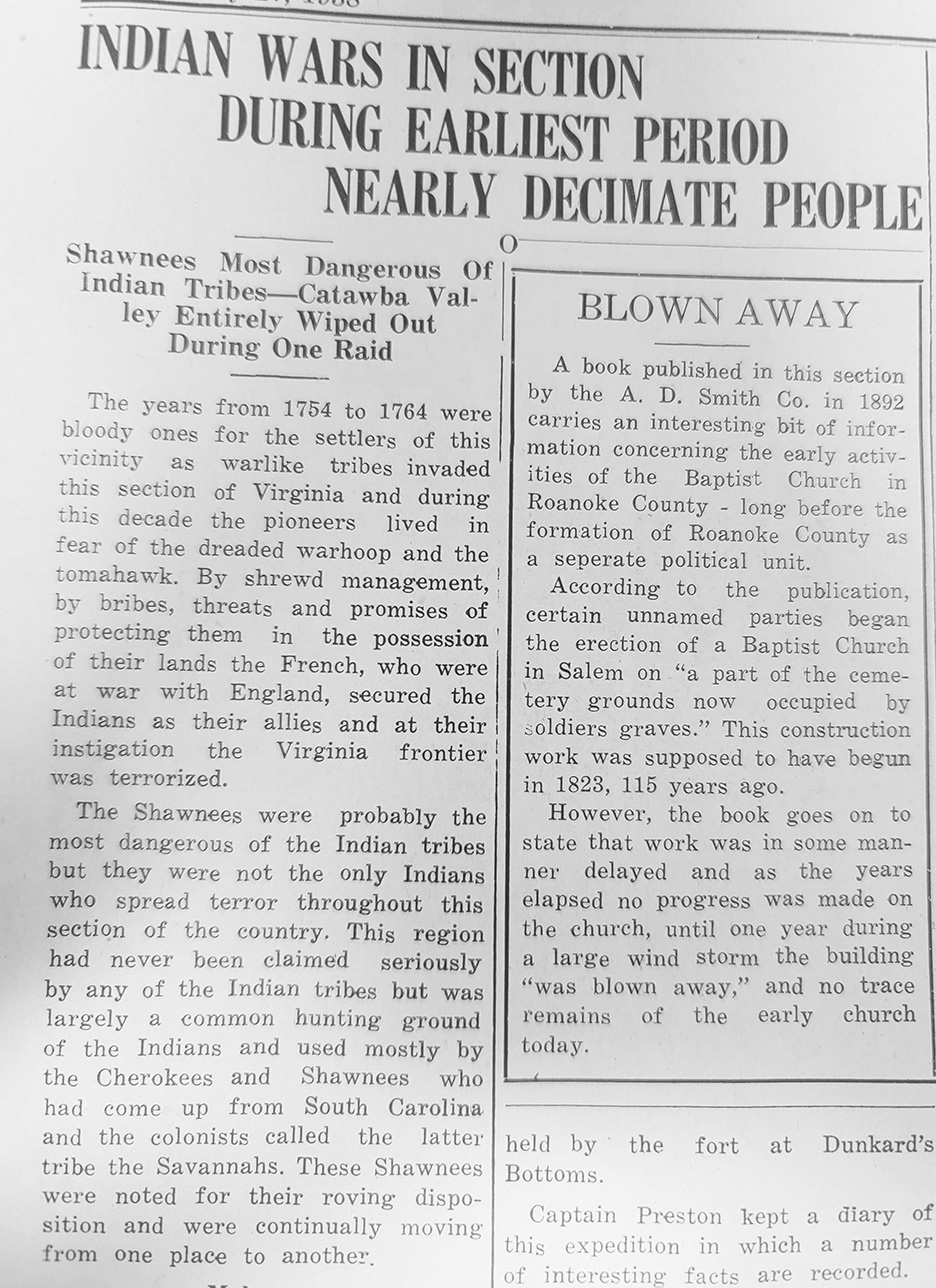 Shawnees Most Dangerous Of Indian Tribes-Catawba Valley Entirely Wiped Out During One Raid
Shawnees Most Dangerous Of Indian Tribes-Catawba Valley Entirely Wiped Out During One Raid
From the 1938 centennial edition of The Times-Register
The years from 1754 to 1764 were bloody ones for settlers of this vicinity as warlike tribes invaded this section of Virginia and during this decade the pioneers lived in fear of the dreaded warhoop and the tomahawk. By shrewd management, by bribes, threats and promises of protecting them in the possession of their lands the French, who were at war with England, secured the Indians as their allies and at their instigation the Virginia frontier was terrorized.
The Shawnees were probably the most dangerous of the Indian tribes but they were not the only Indians who spread terror throughout this section of the country. This region had never been claimed seriously by any of the Indian tribes but was largely a common hunting grounds of the Indians and used mostly by the Cherokees and Shawnees who had come up from South Carolina and the colonists called the latter tribe the Savannahs. These Shawnees were noted for their roving disposition and were continually moving from one place to another.
Mohatans
At one time there was a small tribe called Mohatans who lived between this section and the West Virginia line. This was probably the only tribe in this vicinity that could lay claim to any part of the immediate section as their homeland as they were agriculturally inclined.
On July 8, 1755, a party of Shawnees swooped down on a little settlement known as Draper’s Meadows, which is situated where V.P.I. now stands and killed four people, taking three prisoners and wounding two more. Among those killed was Colonel James Patton, founder of Pattonsburg and one of the first settlers here and who had huge land holdings throughout this section. He was probably visiting Draper’s Meadow at the time of the massacre.
In the spring of 1756, the Shawnees attacked Fort Vause in what is now Montgomery county and the consequences of this attack were more horrible then the massacre at Draper’s Meadow. Prior to the attack on Fort Vause the Indians had committed a number of depredations throughout the vicinity an as a result Governor Dunmore wrote a letter to Major Andrew Lewis asking him to take up arms against the Indians and punish them.
Sandy creek force
Major Lewis was quick to organize a force for the invasion of Indian territory, but it is said by historians that George Washington was opposed to this expedition known as the Sandy Creek expedition. Washington, who was then located in Winchester in charge of military operations knew the country through which Lewis would have to travel and it is probable that he opposed the idea of Governor Dunmore as to the project.
However, the expedition was assembled at Fort Prince George, afterward called Fort Lewis, near Salem on February 9, 1756. Captain William Preston was placed in charge of the vanguard and his forces were joined by Major Lewis with the main body of soldiers.
The name of Captain Preston is found repeatedly in the annals of the early days of this section, with the exception of Andrew Lewis, he was probably the most prominent of the early settlers in the vicinity. He made his home first at Greenfield, in Botetourt county, between Salem and Fincastle.
Four military companies from Augusta county and four companies of volunteers had been assembled with Captain Preston’s force at the New River. A company at that time was composed of twenty-five privates and about six officers. The militia companies of this expedition were commanded by Captain Peter Hogg, William Preston, John Smith, Samuel Overton and Obediah Woodson; the four volunteer companies were under command of Captain Robert Breckinridge, Archibald Alexander, John Montgomery and John Dunlap. In addition to these one hundred or more friendly Indians had been recruited by Captain Richard Pearis and were commanded by him.
400 In Number
On February 19 these men, about four hundred in number, started on their perilous expedition from Fort Frederick which was the name then, held by the fort at Dunkaard’s Bottoms.
Captain Preston kept a diary of this expedition in which a number of interesting facts are recorded. Under a February 20 dateline he notes the following: “Switched one of the soldiers for swearing which much incensed the Indian chiefs then present.” Later, a number of the Indians deserted the expedition, but they were induced to rejoin the party.
This little expedition marched through the Clinch valley and into West Virginia. Captain Preston said in his diary that Sandy Creek was reached on February 28, but local historians are of the opinion that the soldiers did not get as far as this creek. It is known that they followed the Tug river for a considerable distance.
Tug River Named
Johnston in his history of the New River Settlements writes as follows concerning the event that occurred:
“The weather was extremely cold, snow having fallen the march was a difficult one, and the men stopping at Burning Spring (Warfield) took strips of the hides of the buffaloes and boiled them in the burning gas. They cut them into strips and thugs, hence the name Tug River. On leaving the spring they scattered through the mountains and many of them perished, either frozen to death, starved, or killed by Indians. They left, however, some marks by the way, cutting their names on trees on the route pursued by them, notable at the forks of Big Coal and Clear Fork of that river, but these trees have been destroyed in recent years.”
It was a most disastrous expedition; the men suffered terrible hardships. On March 13 th companies captained by Montgomery and Dunlap started back and it was then that Major Lewis probably decided to press no further.
The failure of this expedition resulted in making the Indians more venturesome in their attacks on the frontier. Furthermore, some historians claim that the French were not only furnishing the Indians with arms, ammunition and other supplies but were paying them liberally for the scalps of English settlers.
Roanoke County Massacre
However, there were no disastrous raids made in this county until the year of 1764, when a party of Delaware and Mingo Indians crossed the Ohio and detachments wrought havoc in this county.
In the month of October 1764, a raiding party swept down on the Catawba valley and wiped out every resident of the place, either killing or taking captive every member of the few families that lived there. A deadly raid was also made on the small settlement at Big Lick or Roanoke.
A Captain Paul organized a band of about twenty men who pursued the marauders. He overtook the Indians near the place where Hinton, West Virginia, now stands, and succeeded in freeing prisoners that were being carried back by the Indians.
During these raids the Indians burned a large number of homes in this vicinity and drove off a considerable amount of stock.
At the end of the French and Indian war excursions of hostile Indians ceased and for the next ten years the settlers enjoyed a comparatively peaceful era. Shortly before the Revolutionary war trouble broke out again and it was in 1774 that Andrew Lewis organized is famous expedition that defeated the Indians at Point Pleasant.
-Prepared by Lisa King





